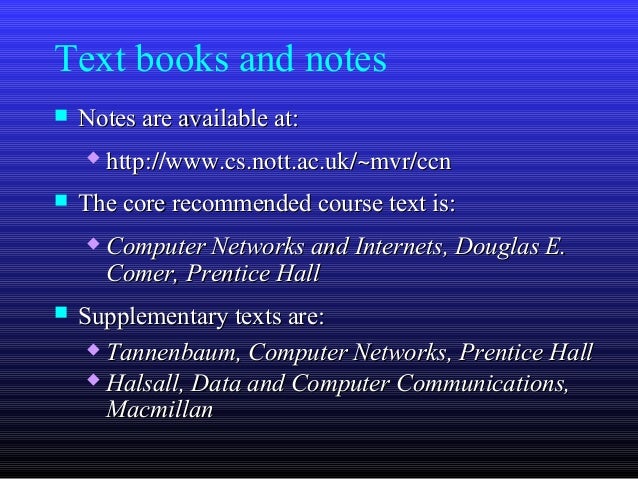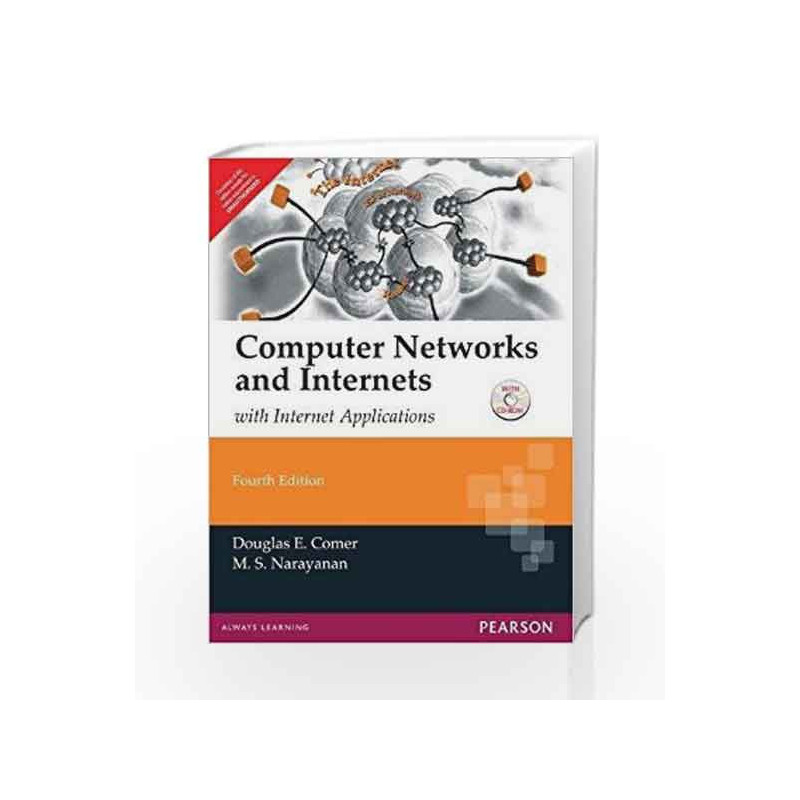- Computer Networks And Internets Douglas E. Comer Pdf 2017
- Computer Networks And Internets Douglas E. Comer Pdf Download
- Computer Networks And Internets Douglas E. Comer Pdf Gratis
Leading networking authority Douglas Comer presents a. Computer software, and lab exercises a reader can perform to. For Computer Networks and Internets.
Description Appropriate for all introductory-to-intermediate courses in computer networking, the Internet, or Internet applications; students need no background in networking, operating systems, or advanced mathematics. Leading networking authority Douglas Comer presents a wide-ranging, self-contained tour of the concepts, principles, and technologies that enable today’s Internet to support applications ranging from web browsing to telephony and multimedia. Comer begins by illuminating the applications and facilities offered by today’s Internet.
274: Computer Networks and Internets: - Review: Here's what they're saying about Computer Networks and Internets by Douglas E. Comer: 'Comer provides. Computer Networks and Internets / Edition 6 by - Dr. Douglas Comer is an internationally recognized expert on TCP/IP protocols, computer networking, and the Internet. 274: Computer Networks and Internets: - Review: Here's what they're saying about Computer Networks and Internets by Douglas E. Comer: 'Comer provides. Computer Networks and Internets / Edition 6 by - Dr. Douglas Comer is an internationally recognized expert on TCP/IP protocols, computer networking, and the Internet. COMER Cisco Research Cisco, Inc. San Jose, CA 95138 and Department of Computer Sciences Purdue University West Lafayette, IN 47907 FIFTH EDITION Computer Networks and Internets Upper Saddle River, New Jersey 07458. Fundamental networking authority Douglas Comer presents a big-ranging, self-contained tour of the concepts, guidelines, and utilized sciences that permit proper now’s Net to assist functions ranging from web purchasing to telephony and multimedia. Comer begins by illuminating the needs and facilities offered by as we converse’s Net. For Computer Networks and Internets. Computer networking, and the Internet. Douglas E Comer. Computer Networks and Internets is appropriate for all introductory-to-intermediate courses in computer networking, the Internet, or Internet applications; readers need no background in networking, operating systems, or advanced mathematics.
Next, he systematically introduces the underlying network technologies and protocols that make them possible. With these concepts and technologies established, he introduces several of the most important contemporary issues faced by network implementers and managers, including quality of service, Internet telephony, multimedia, network security, and network management.
Comer has carefully designed this book to support both top-down and bottom-up teaching approaches. Students need no background in operating systems, and no sophisticated math: Comer relies throughout on figures, drawings, examples, and analogies, not mathematical proofs. Teaching and Learning Experience This program will provide a better teaching and learning experience—for you and your students. Broad Coverage of Key Concepts and Principles, Presented in a Technology-independent Fashion: Comer focuses on imparting knowledge that students will need regardless of which technologies emerge or become obsolete.
Flexible Organization that Supports both Top-down and Bottom-up Teaching Approaches: Chapters may be sequenced to accommodate a wide variety of course needs and preferences. An Accessible Presentation that Resonates with Students: Comer relies throughout on figures, drawings, examples, and analogies, not mathematical proofs. A Companion Web Site that Enhances Learning: The web site for the text includes support material for both students and instructors. Keep Your Course Current: Content is refreshed to provide the most up-to-date information on new technologies for your course. Broad Coverage of Key Concepts and Principles, Presented in a Technology-independent Fashion. Drawing on more than 30 years’ experience at the leading edge of networking research and implementation, Comer focuses on imparting knowledge that students will need regardless of which technologies emerge or become obsolete.
Every chapter includes hands-on exercises and projects that offer opportunities for students to test their knowledge and gain confidence in their abilities. Flexible Organization that Supports both Top-down and Bottom-up Teaching Approaches. The text is organized into five parts.
Chapters may be sequenced in multiple orders to accommodate a wide variety of instructor/student/course needs and preferences. This text combines the best of top-down and bottom-up approaches. When presented in order, the book exposes students to applications and allows them to write network programs early, while delivering all material in logical order so a reader understands how each new technology builds on lower layer technologies. An Accessible Presentation that Resonates with Students. No sophisticated mathematics is required—instead of formal mathematical proofs, Comer presents highly accessible examples, figures, drawings, and analogies. The text answers the basic question: how do computer networks and Internets operate? It provides a comprehensive, self-contained tour through all of networking that describes applications, Internet protocols, network technologies, such as LANs and WANs, and low-level details, such as data transmission and wiring.

It shows how protocols use the underlying hardware and how applications use the protocol stack to provide functionality for users. A Companion Web Site that Enhances Learning. A web site for the text includes supporting material, such as photos of equipment, computer software, and lab exercises a reader can perform to reinforce concepts, as well as instructor materials, such as classroom presentations and copies of the figures. Keep Your Course Current In response to suggestions from readers and recent changes in networking, the new edition has been completely revised and updated. The significant changes include:. NEW! Updates throughout each chapter.
NEW! Additional figures to enhance explanations. NEW! Integration of IPv4 and IPv6 in all chapters. NEW! Improved coverage of MPLS and tunneling.
NEW! New chapter on Software Defined Networking and OpenFlow. NEW! New chapter on the Internet of Things and Zigbee. About the Author(s) Dr. Douglas Comer is an internationally recognized expert on TCP/IP protocols, computer networking, and the Internet.
One of the researchers who contributed to the Internet as it was being formed in the late 1970s and 1980s, he was a member of the Internet Architecture Board, the group responsible for guiding the Internet's development. He was also chairman of the CSNET technical committee, a member of the CSNET executive committee, and chairman of DARPA's Distributed Systems Architecture Board. Comer has consulted for industry on the design of computer networks. In addition to giving talks in US universities, each year Comer lectures to academics and networking professionals around the world. Comer's operating system, XINU, and implementation of TCP/IP protocols (both documented in his textbooks), have been used in commercial products. Comer is a Distinguished Professor of Computer Science at Purdue University. He is currently on leave from Purdue, serving as VP of Research Collaboration at Cisco Systems.
Recently, Comer has taught courses on networking, internetworking, computer architecture, and operating systems. He has developed innovative labs that provide students with the opportunity to gain hands-on experience with operating systems, networks, and protocols. In addition to writing a series of best-selling technical books that have been translated into 16 languages, he served as the North American editor of the journal Software — Practice and Experience for 20 years. Comer is a fellow of the ACM.
This article needs additional citations for. Unsourced material may be challenged and removed. (March 2009) In and, jitter is the deviation from true periodicity of a presumably, often in relation to a reference. In applications it is called timing jitter.
Jitter is a significant, and usually undesired, factor in the design of almost all communications links. Jitter can be quantified in the same terms as all time-varying signals, e.g., (RMS), or peak-to-peak displacement. Also like other time-varying signals, jitter can be expressed in terms of.
Jitter period is the interval between two times of maximum effect (or minimum effect) of a signal characteristic that varies regularly with time. Jitter frequency, the more commonly quoted figure, is its inverse.
Computer Network
G.810 classifies jitter frequencies below 10 Hz as wander and frequencies at or above 10 Hz as jitter. Jitter may be caused by and with carriers of other signals. Jitter can cause a display monitor to flicker, affect the performance of processors in personal computers, introduce clicks or other undesired effects in audio signals, and cause loss of transmitted data between network devices. The amount of tolerable jitter depends on the affected application. Contents. Jitter metrics For jitter, there are three commonly used metrics: Absolute jitter The in the position of a clock's edge from where it would ideally be. Period jitter (aka cycle jitter) The difference between any one clock period and the ideal or average clock period.
Period jitter tends to be important in synchronous circuitry such as digital state machines where the error-free operation of the circuitry is limited by the shortest possible clock period (average period less maximum cycle jitter), and the performance of the circuitry is set by the average clock period. Hence, synchronous circuitry benefits from minimizing period jitter, so that the shortest clock period approaches the average clock period. Cycle-to-cycle jitter The difference in duration of any two adjacent clock periods. It can be important for some types of clock generation circuitry used in and interfaces. In, the unit used for the above types of jitter is usually the (UI) which quantifies the jitter in terms of a fraction of the transmission unit period.
This unit is useful because it scales with clock frequency and thus allows relatively slow interconnects such as to be compared to higher-speed internet backbone links such as. Absolute units such as picoseconds are more common in microprocessor applications. Units of degrees and radians are also used. In the normal distribution one from the (dark blue) accounts for about 68% of the set, while two standard deviations from the mean (medium and dark blue) account for about 95% and three standard deviations (light, medium, and dark blue) account for about 99.7%. If jitter has a, it is usually quantified using the of this distribution (which translates to a RMS measurement for a zero-mean distribution). Often, jitter distribution is significantly non-Gaussian.
This can occur if the jitter is caused by external sources such as power supply noise. In these cases, peak-to-peak measurements are more useful. Many efforts have been made to meaningfully quantify distributions that are neither Gaussian nor have meaningful peaks (which is the case in all real jitter). All have shortcomings but most tend to be good enough for the purposes of engineering work.

Note that typically, the reference point for jitter is defined such that the jitter is 0. In, in particular such as the, jitter can refer to the variation in the delay of the. Types One of the main differences between random and deterministic jitter is that deterministic jitter is bounded and random jitter can be unbounded in some circumstances. Random jitter Random Jitter, also called Gaussian jitter, is unpredictable electronic timing noise. Random jitter typically follows a or Normal distribution. It usually follows this pattern because most noise or jitter in an is caused by, which has a Gaussian distribution.
Another reason for random jitter to have a distribution like this is due to the. The central limit theorem states that composite effect of many uncorrelated noise sources, regardless of the distributions, approaches a Gaussian distribution. Deterministic jitter is a type of timing jitter or data signal jitter that is predictable and reproducible. The peak-to-peak value of this jitter is bounded, and the bounds can easily be observed and predicted. Deterministic jitter can either be correlated to the data stream or uncorrelated to the data stream (bounded uncorrelated jitter). Examples ofMinimizing the effects of sampling jitters in wireless sensors networks'.
Decomposition Jitter signal can be decomposed into (IMFs), which can be further applied for filtering or dejittering. See also. References.
From the Publisher: The Second Edition of this best-selling text continues to answer the question, “How do computer networks and internets operate?” Douglas. Computer Networks and Internets, 6th Edition. Douglas E. Comer, Purdue University. © |Pearson | Available. Share this page. Computer Networks and . Strayer University. Computer Networks and Internets. By: Douglas E. Comer http ://~cs/lecture_notes/ CHAPTER.
| Author: | Voodooshura Feramar |
| Country: | Timor Leste |
| Language: | English (Spanish) |
| Genre: | Personal Growth |
| Published (Last): | 4 November 2017 |
| Pages: | 270 |
| PDF File Size: | 14.7 Mb |
| ePub File Size: | 7.85 Mb |
| ISBN: | 203-1-17357-262-3 |
| Downloads: | 84554 |
| Price: | Free* [*Free Regsitration Required] |
| Uploader: | Magrel |
Computer Networks And Internets Douglas E. Comer Pdf 2017

We use cookies to give you the best possible experience. By using our website you agree to our use of cookies.
Home Contact Us Help Free delivery worldwide. Computer Networks and Internets, with Internet Applications: Written by a best-selling author and leading computer networking authority, Computer Networks and Internets, Third Edition builds a comprehensive picture of the technologies behind Internet applications.
Computer Networks and Internets, with Internet Applications : International Edition
Computer Networks And Internets Douglas E. Comer Pdf Download
Ideal for those with little or no background in the subject, the text answers the basic question “how do computer networks and Internets operate? The text provides a comprehensive, self-contained tour through all of networking from the lowest levels of data transmission and wiring to the compiter levels of application software, explaining how underlying technologies provide services and how Internet applications use those services.
Computer Networks And Internets Douglas E. Comer Pdf Gratis
At each level, it shows how the facilities and services provided by lower levels are used and extended in the next level. For instructors who want to emphasize Internet technologies and applications, the book provides substantial sections on Internsts and Network Applications that can serve as a focus for a course. The Best Books of Check out the top books of the year on our page Best Books of Looking for beautiful books? Visit our Beautiful Books page and find lovely books for kids, photography lovers and more.
Table of contents 1. Network Programming and Applications. Local Asynchronous Communication RS Packets, Frames and Error Detection. Hardware Addressing and Frame Type Identification. Fiber Modems, Repeaters, Bridges, and Switches.
Long-Distance Digital Connection Technologies.
WAN Technologies and Routing. Ownership, Service Paradigm, and Performance.

Concepts, Architecture, and Protocols. IP Datagrams and Datagram Forwarding.
Comer, Computer Networks and Internets, 6th Edition | Pearson
IP Encapsulation, Fragmentation, and Reassembly. Example of a Client and a Server. Naming with the Domain Name System. Electronic Mail Representation and Transfer. File Transfer and Remote File Access.
World Wide Web Pages and Browsing. Glossary of Networking Terms and Abbreviations. Address Masks in Dotted Decimal.
The Undergrad Networking Lab at Purdue.